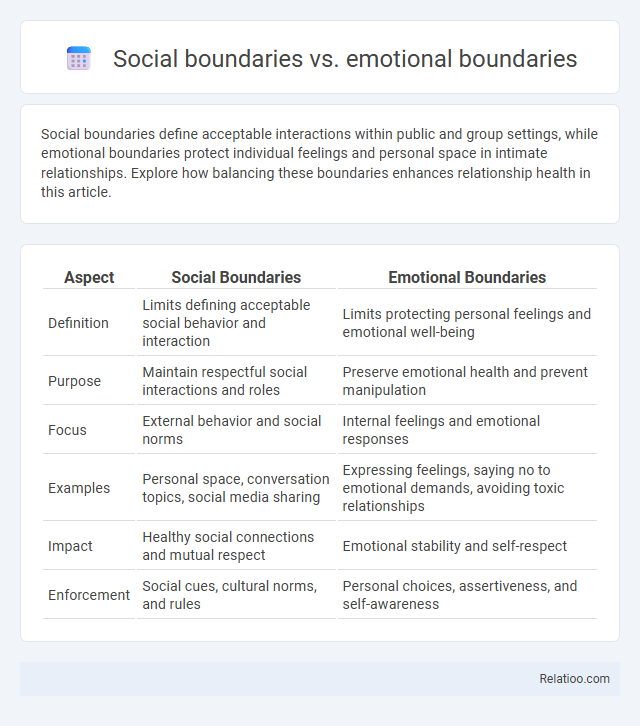Social boundaries define acceptable interactions within public and group settings, while emotional boundaries protect individual feelings and personal space in intimate relationships. Explore how balancing these boundaries enhances relationship health in this article.
Table of Comparison
| Aspect | Social Boundaries | Emotional Boundaries |
|---|---|---|
| Definition | Limits defining acceptable social behavior and interaction | Limits protecting personal feelings and emotional well-being |
| Purpose | Maintain respectful social interactions and roles | Preserve emotional health and prevent manipulation |
| Focus | External behavior and social norms | Internal feelings and emotional responses |
| Examples | Personal space, conversation topics, social media sharing | Expressing feelings, saying no to emotional demands, avoiding toxic relationships |
| Impact | Healthy social connections and mutual respect | Emotional stability and self-respect |
| Enforcement | Social cues, cultural norms, and rules | Personal choices, assertiveness, and self-awareness |
Understanding Social Boundaries
Understanding social boundaries involves recognizing the limits and expectations that govern interactions between individuals and groups in various social contexts. Social boundaries define appropriate behavior, communication styles, and personal space, helping to maintain respect and prevent conflicts in relationships. Unlike emotional boundaries, which protect individual feelings and mental well-being, social boundaries focus on external interactions and societal norms.
Defining Emotional Boundaries
Emotional boundaries protect your feelings by clearly separating your emotions from others', preventing emotional entanglement and allowing you to maintain self-awareness and control. While social boundaries regulate acceptable behavior and interactions in social settings, emotional boundaries specifically address the limits of emotional involvement and vulnerability. Defining emotional boundaries involves recognizing your emotional limits, expressing your needs clearly, and refusing to internalize others' emotional experiences.
Key Differences Between Social and Emotional Boundaries
Social boundaries define the limits you set in interactions and relationships to maintain appropriate social conduct and respect, while emotional boundaries protect your inner feelings and prevent emotional manipulation or overwhelm. Your social boundaries determine how much personal information or physical space you share with others in various social settings, whereas emotional boundaries regulate your emotional involvement and ensure you are not overly responsible for others' feelings. Understanding these key differences helps you maintain healthy relationships by balancing external social interactions with internal emotional well-being.
Importance of Setting Boundaries in Relationships
Setting clear social boundaries allows individuals to define their comfort zones in interpersonal interactions, preventing overexposure and maintaining personal space. Emotional boundaries help protect one's mental well-being by regulating the extent of empathy and emotional involvement, reducing vulnerability to manipulation or emotional burnout. Establishing both social and emotional boundaries is crucial for fostering healthy relationships, promoting mutual respect, and ensuring balanced communication between partners, friends, or colleagues.
How Social Boundaries Impact Interpersonal Interactions
Social boundaries define appropriate behaviors and interactions within groups, shaping how individuals engage and communicate in various social contexts. Emotional boundaries regulate personal feelings and limit emotional exposure, ensuring emotional safety and mutual respect in relationships. Clear social boundaries foster trust and respect, reducing conflicts and misunderstandings during interpersonal interactions by setting expectations and protecting personal autonomy.
Emotional Boundaries and Personal Well-being
Emotional boundaries are crucial for personal well-being, as they help individuals distinguish their own feelings from others', preventing emotional overload and maintaining mental health. Unlike social boundaries that regulate interpersonal interactions and set acceptable behavior in social contexts, emotional boundaries protect inner emotional space, fostering self-respect and resilience. Strong emotional boundaries enable healthier relationships by promoting clear communication and reducing codependency, which contributes significantly to overall emotional stability.
Common Challenges in Maintaining Boundaries
Common challenges in maintaining social, emotional, and interpersonal boundaries include unclear communication, fear of rejection, and difficulty asserting personal limits. Many individuals struggle with distinguishing where their responsibilities end and others' begin, leading to boundary violations and emotional burnout. Consistent awareness and reinforcement of boundaries are essential to prevent confusion and maintain healthy relationships.
Strategies for Establishing Healthy Social Boundaries
Establishing healthy social boundaries involves clear communication of personal limits regarding time, energy, and privacy to prevent social overwhelm and maintain respectful interactions. Strategies include assertive expression of needs, consistent reinforcement of limits, and selective engagement with social activities that align with one's values and comfort levels. Prioritizing self-awareness and regularly evaluating relationships ensures social boundaries support emotional well-being and reduce interpersonal stress.
Techniques to Strengthen Emotional Boundaries
Strengthening emotional boundaries involves techniques such as mindfulness meditation to increase self-awareness and emotional regulation, practicing assertive communication to express personal needs clearly, and setting limits on emotional energy spent on others to prevent burnout. Social boundaries refer to the external limits we set in interactions, while emotional boundaries protect our inner feelings and mental well-being from being overwhelmed or manipulated. Prioritizing emotional boundaries enhances resilience and fosters healthier relationships by maintaining a clear distinction between one's emotions and others'.
Signs of Violated Social and Emotional Boundaries
Signs of violated social boundaries include discomfort during personal space invasion, unsolicited advice, or ignoring your need for privacy in group settings. Emotional boundary violations manifest as manipulation, excessive emotional demands, or invading your right to process feelings independently. Recognizing these signs helps you maintain healthy relationships and preserve your well-being.

Infographic: Social boundaries vs Emotional boundaries
 relatioo.com
relatioo.com